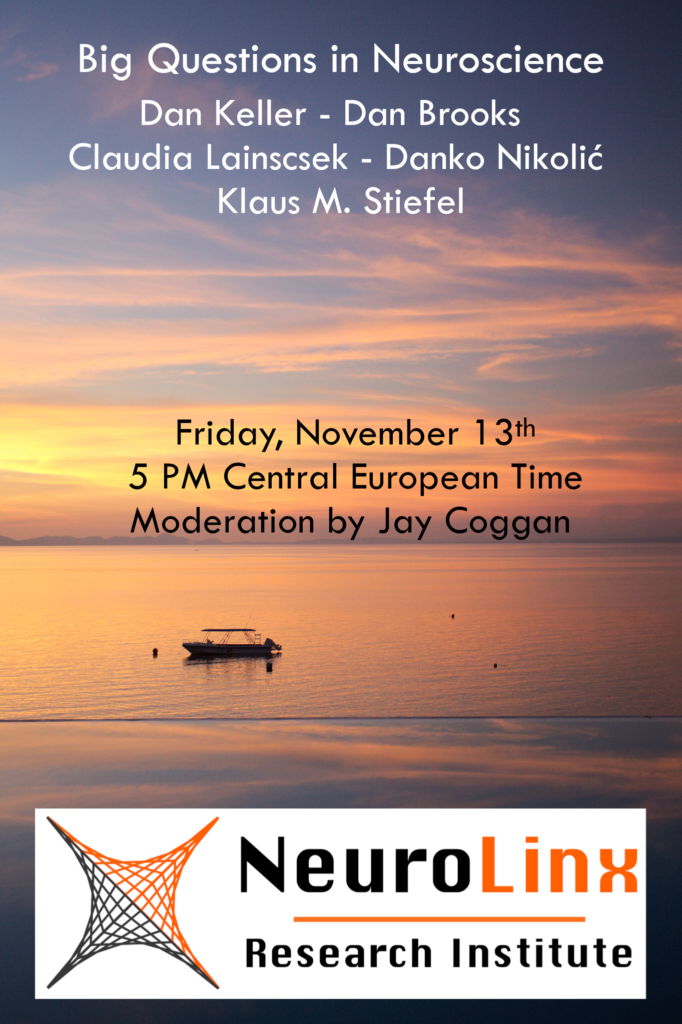Big Questions in Neuroscience, Part 1.
November 13th, 5:00 PM (17:00) Central European Time (CET)
Zoom: Nov 13, 2020 08:00 AM Pacific Time (US and Canada)
Join Zoom Meeting: https://zoom.us/j/99207286971?pwd=REJUTmFEMy9CVVc0QklTVWFIbjdzQT09
Meeting ID: 992 0728 6971 Passcode: 751062

Program:
Klaus M. Stiefel, PhD
NeuroLinx Research Institute and
Institute of Environmental and Marine Sciences
Silliman University, Dumaguete, Philippines
Title: Evolutionary Brain Modifications Resulting from Symbiosis
Abstract: More than 120 species of gobies, small bottom-dwelling marine fishes, live in a symbiosis with alpheid shrimp. In this partnership the shrimp excavate a burrow, while the goby acts as a watchman on the entrance of the burrow, alerting the shrimp of approaching threats such as predatory fishes by way of a tactile communication system.
We propose that an additional (likely indirect) connection from the sensory systems of the goby to the swimming central pattern generator is the underlying neural basis of the tactile communication system used by the fish. We test this hypothesis by running simulations of an abstract model of the basal fish hindbrain escape system, and of the modified shrimp goby hindbrain system, and find neural dynamic consistent with the observed communication system.
We see in this study how a minor modification in a hindbrain circuit leads to a qualitative modification of behavior which in turn leads to a significant change in the ecological success of a species. The concepts of levels in biology here bridges from neuroscience to ecology.
Boris Gutkin, Ph.D. (in a collaboration with Mehdi Keramati and Serge Ahmed)
Ecole Normale Superieure: Paris, France
Title: Misdeed of the need: transition to addiction as a pathology of homeostatically regulated learning.
Abstract: Drug addiction is a complex behavioral and neurobiological disorder characterized by a marked inability to control drug seeking and intake despite clear negative consequences. This transition to addiction reflects a loss of cognitive control over behavior and from a brain-circuit view – withdrawal of prefrontal top-down control over subcortical circuits governing drug-seeking and drug-taking. In this talk, I will focus on cocaine addiction. I will first review previous computational accounts of addiction, focusing on the prevalent dopamine-based positive-reinforcement and negative-reinforcement computational models. Then, I will discuss our computational proposal that the progression to addiction is unlikely to result from a complete withdrawal of the goal-oriented decision system in favor of the habitual one. Rather, the transition to addiction would arise from a drug-induced alteration in the structure of organismal needs which reorganizes the goal structure, ultimately favoring predominance of drug-oriented goals. Finally, I will outline unmet challenges for future computational research on addiction.
In summary I will argue, that addictive drugs go deeper than just providing pharmacological rewards, but alter the very nature of what we consider as our life goals, and narrow the horizon of our motivations toward the one predominant desire for the drug.
Daniel Keller, PhD.
The Blue Brain Project
Title: Large-and multi-scale brain modeling: a perspective
Abstract:
Several practical considerations arise when modeling brains at different scales. There is a tradeoff between detail and computational performance, so one should choose a level of detail appropriate to the question at hand. There are also challenges when linking different simulators modeling effects occurring at different temporal and spatial scales. Finally, all modeling faces the issue of missing data used to parameterize the system. There are different approaches and philosophies of how to deal with this in the context of brain modeling at scale.
Daniel S. Brooks, Ph.D.
Department of Philosophy
University of Cincinnati, OH, USA
Title: The Problem with Whole Brain Simulations: Organizational Levels and Progress in Neuroscience
Abstract: With the advent of powerful parallel computers, efforts have commenced to simulate complete mammalian brains. However, so far none of these efforts have produced outcomes close to explaining even the behavioral complexities of animals. In fact, many are decried as failing outright. In this talk I outline two issues underlying this apparent failure, garnered from collaborative conversations (and a co-authored paper) between a neuroscientist and a philosopher. First, I consider the much-abused rhetoric found in many whole-brain simulation studies concerning the ‘multi-level’ structure of the brain, offering a genuine challenge to neuroscientists who apply this framework for ordering their research. Second, and relatedly, I consider the nature of progress in the neurosciences, arguing that achievements that advance our knowledge of nervous systems are not “sweeping” (as many modelers and simulators claim), but rather “creeping.” I conclude with some reflective upshots concerning the benefits of investing in more theoretical dialogues concerning matters of importance to research communities.
Danko Nikolić, PhD
Savedroid and RobotsGoMental.
Title: Neurons adapt quickly: Can this be the essence of our intelligence?
Abstract:
We usually assume that the intelligence of a neuronal network is implemented in its wiring. Hence, neuroscience has been dominated by the so-called “connectionism paradigm”. I think this needs to be changed. I would like to propose the “adaptational paradigm”. Hereby, the intelligence of a neural network primarily comes from how neurons learned to quickly adapt–within 100s of milliseconds. I propose that the pattern of adaptation resulting from a given stimulus is the mental “operation” that the network has executed in response to that input. Notably, I propose that neurons learn these fast adaptations. Intrinsic plasticity mechanisms responsible for changing the fast adaptive properties of a nerve cell are, according to this theory, the most important ones for our mental development–a lot more important than synaptic plasticity. I will also report empirical evidence from our recent behavioral experiment in support of these ideas.
Claudia Lainscsek, PhD
The Salk Institute for Biological Studies
La Jolla, CA, USA
Title: The application of DDA to seizure detection and prediction
Abstract: Addressing the problem of how to read brain electrical signals is central to the non-invasive diagnosis of brain disorders and brain-computer interfaces (BCI). As a case study, the application of delay differential analysis (DDA) to interpret EEG signals will be demonstrated for seizure detection and predictions.
